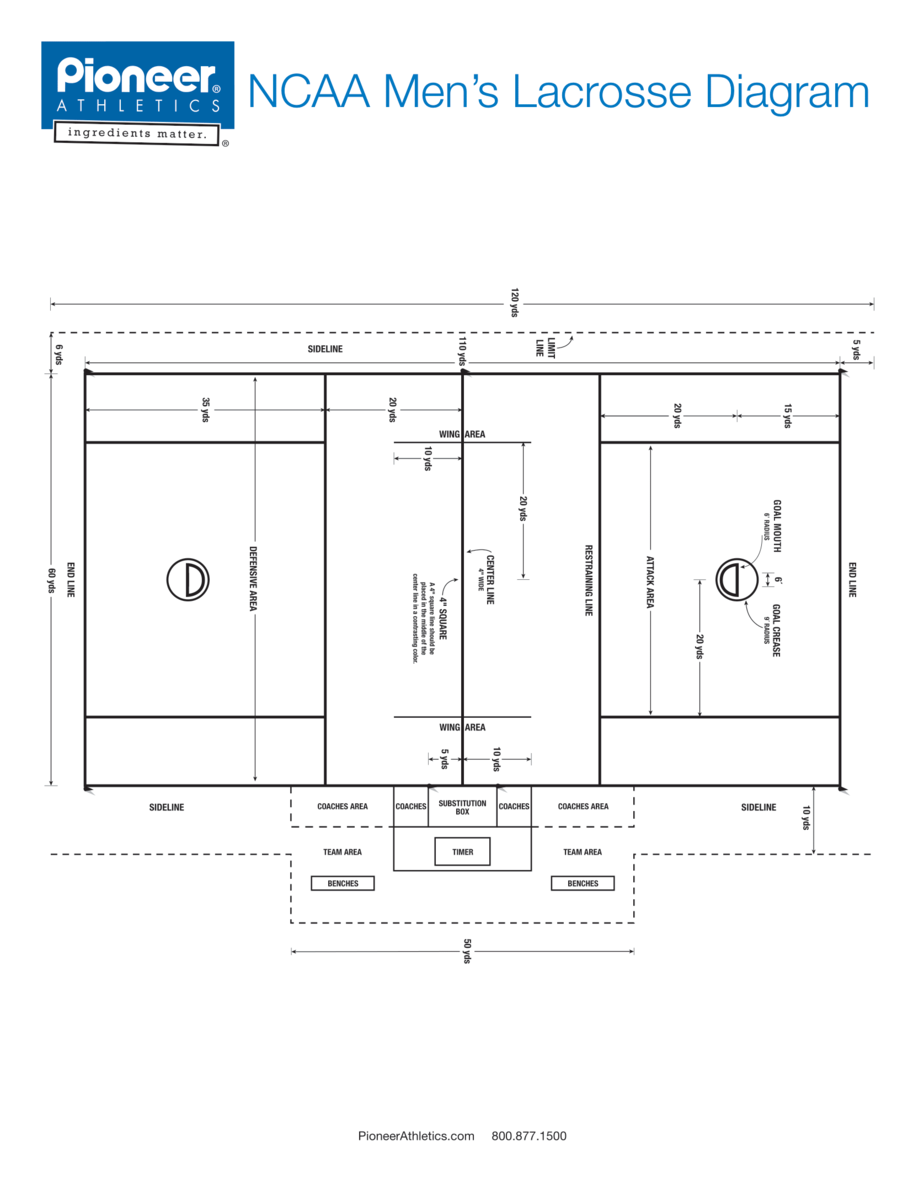

Lacrosse Field Diagram: Breaking Down the Key Zones and Markings
A well-marked lacrosse field isn’t just about paint on the grass, it shapes the entire flow of the game. For players, it defines where they can create opportunities or shut them down. Coaches rely on field markings to drill strategy, while event organizers depend on proper setup to meet competition standards.
Lacrosse fields aren’t one-size-fits-all. Dimensions and markings shift depending on gender, age group, and competition level, making it critical to understand the nuances. Whether preparing a youth league game or a collegiate championship, knowing the zones and lines ensures fair play and sharp execution.
This article offers a clear, detailed breakdown of each zone and marking on a lacrosse field. By the end, you’ll have a firm grasp of the full layout—whether you’re on the field, on the sidelines, or setting up the next big match.
Overview of Lacrosse Field Layout
The standard lacrosse field is a rectangle measuring about 110 yards in length and 60 yards in width. These dimensions apply to most men’s outdoor games, though women’s lacrosse fields and youth fields can differ, often being slightly larger or smaller depending on regulations.
Major Zones
Every lacrosse field includes several key zones, each with its own purpose:
-
Attack Area: The offensive end where teams focus on scoring.
-
Defense Area: The defending team’s territory, protecting the goal.
-
Midfield: The center strip of the field that connects offense and defense.
-
Goal Crease: The circular area surrounding the goal, reserved primarily for the goalie.
-
Penalty Box: The holding area for players serving penalties.
Field Orientation
Lacrosse fields are laid out with a goal at each end and a midfield line cutting across the center. This midfield line isn’t just decorative - it splits the field into offensive and defensive halves, guiding player movement and substitutions.
Why the Layout Matters
Field layout isn’t just a technicality - it drives everything from player positioning to tactical decisions. Attackers need to know where to push forward; defenders need to hold their ground inside key zones; referees rely on clear markings to apply rules correctly. Without a precise, standardized layout, the fast pace and high-contact nature of lacrosse would quickly turn chaotic.

Key Zones on a Lacrosse Field
Goal Area (Crease)
The goal area, often called the crease, is a circular zone around the goal. In men’s lacrosse, it measures 18 feet in diameter. For women’s lacrosse, the crease expands to 8.5 meters, or about 28 feet.
The crease plays a crucial role in protecting the goalie. Within this space, the goalie has the freedom to move and defend without interference. Offensive players, however, are strictly prohibited from stepping inside. Crossing into the crease leads to an immediate turnover, while goalies who leave the crease lose their unique privileges, making them vulnerable to stick checks and pressure.
Attack Zone
Located directly in front of the opponent’s goal, the attack zone typically stretches 35 yards deep. This area serves as the beating heart of offensive strategy, where teams run plays, set picks, and work to create scoring chances.
Attackmen take charge here. Their role centers on generating offense, maneuvering around defenders, and setting up high-percentage shots. Understanding the attack zone’s layout helps players maintain spacing, avoid turnovers, and maximize scoring opportunities.
Defensive Zone
The defensive zone mirrors the attack zone but on the team’s own side of the field. It spans about 35 yards deep and serves as the last line of defense before the goal.
Defenders focus on blocking shots, forcing turnovers, and clearing the ball upfield. Inside this zone, protecting the crease becomes the top priority. Goalies rely on defenders to keep opposing attackers at bay, using stick checks, body positioning, and communication to hold the line.
Midfield Zone
The midfield zone covers the center strip of the field, split by the midfield line. It’s home to two critical features: the Faceoff X and the wing areas.
-
The Faceoff X marks the spot where play restarts after each goal and at the beginning of quarters.
-
Wing areas, located 10 yards from either side of the Faceoff X, position players for faceoff support and quick transitions.
Midfielders own this zone. They’re the engine of the team, bridging offense and defense. Whether it’s winning faceoffs, pushing fast breaks, or tracking back to help the defense, midfielders need a strong grasp of the midfield’s layout to stay effective.
Restraining Lines
Restraining lines sit 20 yards from each goal line and serve a critical regulatory purpose. They control how many players from each team can occupy the offensive and defensive ends at any time.
Without restraining lines, teams would flood the attack or defense zones, creating chaos. Instead, they help keep the game balanced, ensuring only designated players cross into specific areas. Understanding these lines matters for players and coaches alike, as violations can quickly shift possession and momentum.
Markings and Lines on a Lacrosse Field
Sidelines and End Lines
Sidelines run the length of the field, while end lines mark the width behind each goal. Together, they define the playing boundaries. When the ball crosses these lines, play stops, and possession changes. Players, coaches, and referees all rely on these clear boundaries to keep the game fair and fast-moving.
Goal Line Extended (GLE)
The Goal Line Extended, or GLE, runs parallel to the goal line and stretches out to meet the sidelines. While it’s an invisible line on some fields, its role is huge. Referees use the GLE to judge whether players have crossed into restricted spaces or if a goal-scoring opportunity is legitimate. Attackers and defenders also treat the GLE as a key tactical line, shaping how they position themselves during plays.
Substitution Box
The substitution box sits near the midfield line, typically on the same side as the team benches. Players use it to enter or leave the field without causing illegal substitutions. With lacrosse’s rapid pace, seamless substitutions matter. Teams that master quick, clean changes often gain an edge, especially in tight games.
Penalty Box
Next to the substitution box, the penalty box holds players serving time for fouls. Time spent here leaves a team short-handed, giving the opponent a temporary advantage. Knowing its location helps players avoid unnecessary penalties and allows coaches to adjust their strategies when short-handed.
Wing Areas
Wing areas flank the midfield line, positioned about 10 yards on either side of the Faceoff X. They’re crucial during faceoffs, as wing players race in to secure possession once the ball is released. Quick reactions in the wings can shift momentum in seconds, turning a faceoff into a fast break or defensive stand.
Women’s Lacrosse Field Layout
Differences from Men’s Field
Women’s lacrosse fields stretch slightly larger, measuring around 120 yards long and 70 yards wide. This extra space creates a faster, more open style of play, with rules and markings designed to match.
Key Markings
-
8-Meter Arc: Marks the shooting space around the goal, limiting defensive obstruction.
-
12-Meter Fan: Defines the primary scoring area and shapes offensive movement.
Additional Lines
-
Restraining Line: Controls player movement, preventing overcrowding near the goal and ensuring balanced play across the field.
Diagram
A well-designed diagram showing the women’s field layout, with all zones and markings labeled, gives players and coaches a clear reference. Including this visual element helps simplify complex rules and supports better field awareness.
